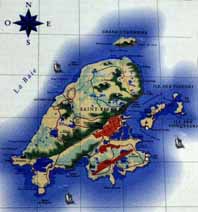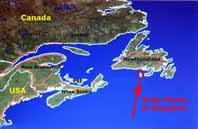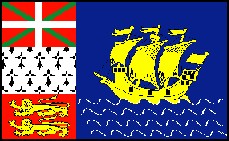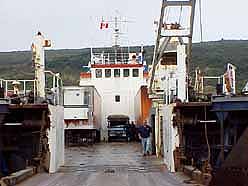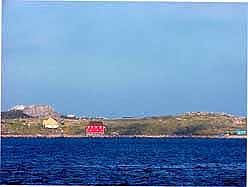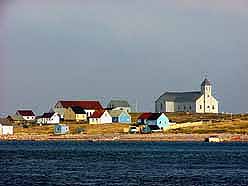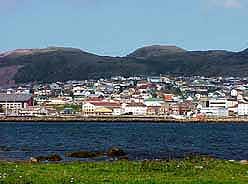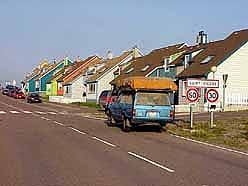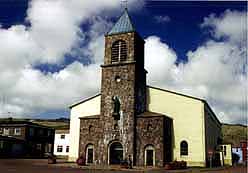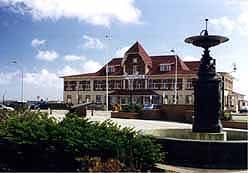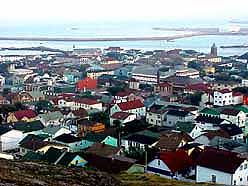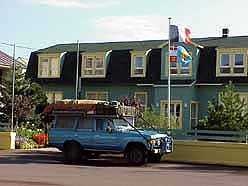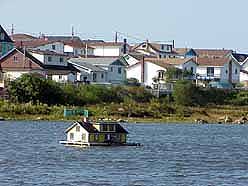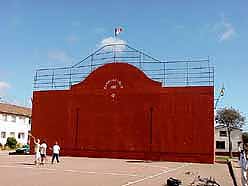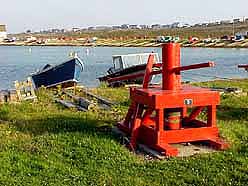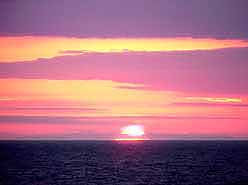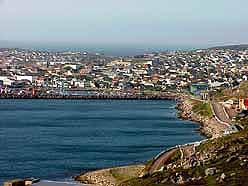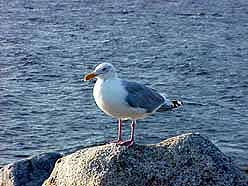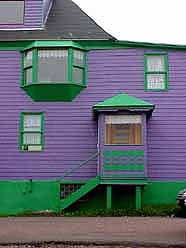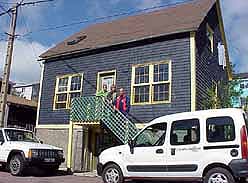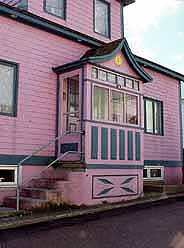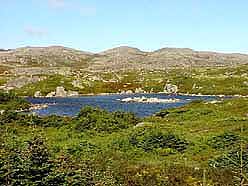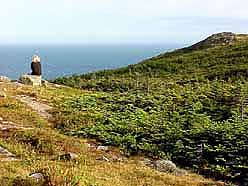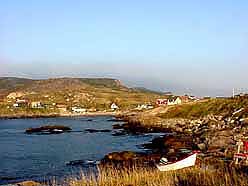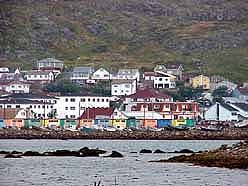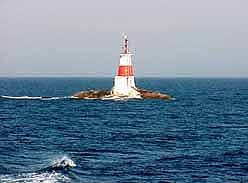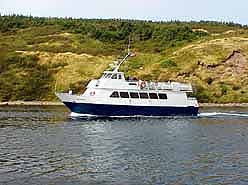Enjoy some pictures of the worldrecordtour taken in Saint Pierre et Miquelon
|
|
click a picture to see details |
|
|
|
|
|
|
|
|
|
|
|||
|
|
|
|
|
|||
|
|
|
|
| As we slowly approach the small French territory, the evening glow could not be more intense. The first glimpse is the tiny off-shore islet “Ile aux Marins”, a hamlet with a few scattered, pastel colored wooden fishing houses and a lonely church, spreading harmony and peace. But this is only the first overwhelming impression of the Nordic beauty and charm of these isolated islands, the existence of which most of the Americans do not even know. As soon as we disembark, we are in a hurry to get the immigration done, as in just another hour the customs authorities are closing down and we want yet to get our car released. While speeding to the little wooden building, we see an attractive lady waving excitedly in our direction. Does she really mean us? Yes, she definitely does! It is Marie-Josée with her little daughter Joséphine, working at the local TV station - Télé St. Pierre et Miquelon/RFO. She apparently got to know of an imminent arrival of “strange” visitors and obviously figured out that we must be the ones. It does not happen very often that foreigners with an own car land on her small world with only 15 miles of road totally. After having done immigration, she offers obligingly to drive us to the Ro-Ro-Freight Service office where we first have to pay the freight bill, and afterwards to the customs for the car’s entry procedures. On the way, she quickly stops at a bakery and buys some delicious French pastries for us as a lovely welcome gesture. Having no French currency with us, makes the payment complicated, the more than the bank already closed. And without payment, there is no car release! We loose precious time until they finally accept US dollars. Then we rush to the customs authorities. Soon after we entered the compound, we are told that the customs boss wants to see us. What is wrong? Will he make us problems? Our chances to make it back to the harbor before 5pm disappear instantly. It is with mixed feelings, that we enter his spacious office and wait nervously what he has to reveal. With a big smile, he tells us that his parents are Swiss - the reason why he wants to welcome us personally on his island. What a nice surprise! When he finds out that we drove through Guinea Conakry in Africa at the same time as he was stationed there, the conversation becomes warmer and more intense. 5pm is long over when we finally leave his office. A nervous Marie-Josée is waiting outside impatiently. Only thanks to her vigorous intervention, our car was meanwhile driven out of the customs compound and the responsible officer for its release has been asked to wait for us. But we are stopped again. The car’s third party insurance problem suddenly pops up. "We do not accept any American insurance", says one of the customs staff. “You need the ‚carte verte’ - a green insurance policy”. Of course, we are on a tiny bit of Europe in America! Minutes before the insurance company closes, we are able to get the costly paper.
|
|||
|
|
|
|
| When we were reunited with our “buddy” again, the red ball of the setting sun is already pretty low. Nothing can stop us anymore - every minute of this beautiful evening is precious. Who knows, already tomorrow fog might hide all this Nordic charm fascinating us around each corner. Very attractive is the traditional architecture of the multicolored houses with their decorative bay-windows, called “tambours”, perched along the sea shore and lining the steep and narrow streets. A surprising sight, however, are the many parked vehicles on the steep narrow streets – far too many for a place with only 15 miles of streets to drive. We go past the picturesque fishing harbor with its bright red boat winches. And soon after, we are surrounded by untouched nature - by tundra in its warm fall colors; a calm pond looking like a mountain lake nestling between alpine hills, surrounded by small fir-trees, and a rugged coast reflecting the harsh elements of the North. Horses roam freely on flowering meadows and on the old airstrip – it is an atmosphere of tranquility. Just before the last rays of the sunset reach the colorful painted houses, we finally find the windy road up hill to the view point overlooking the town. The panorama below us is just awesome. The whole city is glistening in the setting sun and the small light house of “Pointe aux Canons”, which has guided since centuries seafarers home day and night and during all weather conditions, starts to beam. "Bon Soir" - a voice besides us interrupts this magic moment. It is the customs boss, whom we left only two hours ago. He also takes advantage of this clear evening and enjoys the serenity of this place together with his wife and his black African dog. It certainly will not be our last encounter – on St. Pierre, it is impossible to run away from each other. When we finally move to a quiet side road and park for the night, all the street lights are long lit up.
|
|||
|
|
|
|
| The powerful fog-horn and the distant call of a lonely horse are the only sounds interrupting the silence of the night. Next morning, as soon as we move outside, we are immediately drenched by the incredible humidity. Water is dripping continuously from our car’s roof, as if it would have rained. Everything looks just gray. All the beauty, which surrounded us last night and made our hearts beat, is now covered in dense fog. At 9am, Marie-Josée is waiting for us at the TV station and introduces us to her curious and friendly film crew. Many months have passed since we last could practice our knowledge of French. But we are familiar with it surprisingly fast again, and all of us have a lot of fun at our filming sessions on this foggy morning. At lunch, life comes to a complete rest. No shop, no supermarket, no gasoline station, no post office - absolutely nothing is open between 12 and 1.30 pm. The children come home from school for lunch. The main diet is still fish, which was more than plentiful in earlier times. The most desired species is the Atlantic cod fish, which is connected very strongly with these islands. Its abundance promised a good livelihood and attracted settlers from Spain, England and France. But since a few yeas, it stayed away due to over fishing. Even a temporarily fishing ban could not bring it back; it did not reproduce as hoped, which forced the fishermen to look for other, less loved species like shrimps and herrings. The Atlantic cod fish is also the seal’s favorite diet; it apparently has reached a record weight of 220 pounds. The fishing zone is limited to twelve sea miles – reason enough to cause a constant dispute with the neighbors of Newfoundland.
|
|||
|
|
|
|
|
|||
|
|
|
|
| During the famous epoch of the big prohibition of the 1930’s in the USA, Saint Pierre played an important role. It is no secret that this small archipelago became the most important whisky reloading place for the famous gangster boss Al Capone. It is said that 300’000 cases left the island monthly. This in the United States forbidden, but most appreciated alcohol was distilled in Canada and exported legally in huge quantities to Saint Pierre, where it was stored, repacked and smuggled into the United States. The original whisky cases were left behind and reused. They are still found in walls of old houses. “Everything is reused here”, Michel explains. He points to his garden fence, which is made of used Canadian Christmas trees, and to his decorative garden chair, containing the dorsal of a blue whale. The screeches of seabirds wake us up next morning. We hear the wave’s gentle splashing and smell the salty air of the sea. A kind of peace lies over this misty place, as we have our breakfast. But suddenly - as if St. Pierre would like to improve its reputation - the sun flashes through the clouds and shortly afterwards, an upcoming strong wind is blowing all the clouds away. The blue, yellow, red and green colors of the neat houses seem more intensive than before. As we arrive at the freight harbor at 11am, “Aldona” is ready to sail. Unfortunately, today is our last opportunity for the coordinated transport of the car and we back to Canada in this ending season. We would have loved to remain a little longer and discover also the bigger and even more remote neighbor island of Miquelon-Langlade, measuring 216 km2. Marie-Josée, who has been taking good car of us during our whole stay, invites us for lunch before the passenger ferry “Maria Galante” is sailing. The main square General Charles de Gaulle opposite of the pier with its cozy bars and restaurants is still deserted on this early afternoon when we board with two fresh French baguettes and a Camembert under the arm – one of the many farewell presents from Marie-Josée. She is waving at us until we disappear in the open sea. We landed on this remote corner of the world as complete strangers, and after only two days we leave with the wonderful feeling that now we have special friends here too.
|
|||
|
|
|
|
